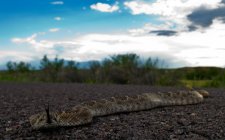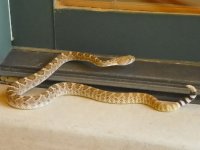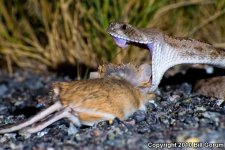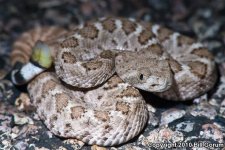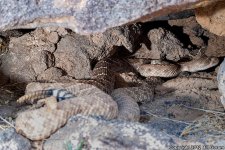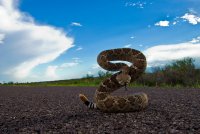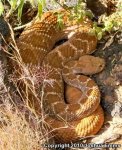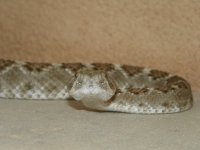| Range: |
 Crotalus atrox occurs from central Arkansas, south/central Oklahoma, most of Texas, New Mexico and Arizona and into Southern Californa, as well as into northern Mexico.
Crotalus atrox occurs from central Arkansas, south/central Oklahoma, most of Texas, New Mexico and Arizona and into Southern Californa, as well as into northern Mexico. |
| Other Names: |
Coontail Rattler, Adobe Snake, Arizona Diamond Rattlesnake, Desert Diamond-back, Desert Diamond Rattlesnake, Fierce Rattlesnake, Spitting Rattlesnake, Texan Rattlesnake, Texas Diamod-back, Western Diamond Rattlesnake, Western Diamondback Rattlesnake |
| Description: |
The largest rattlesnake in New Mexico, it can obtain lengths in excess of 4 feet! The pattern consists of diamonds along the back. The base color of the snake varies and can be red, copper, brown, gray, etc. The tail is banded black and white and tipped with a rattle. Various morphs have been found including: amelanistic (albino), melanistic, striped and patternless. Some of these morphs can be seen at the Rattlesnake Museum. There have also been some cases of hybrids with Crotalus viridis or a viritrox |
| Similar Species: |
Can easily be distinguished from all other rattlesnakes in New Mexico by its black and white banded tail except for the Mojave. Diamondbacks average four or more scales between their ocular scales, Mojaves rarely have more than two or three such scales. In addition, the white and black tail bands of the diamondback are usuallyequal (or close to it) in width, while the Mojave usually has wider white bands. The scales that forn the light-colored edges around the dorsal blotches of the diamondback are generally not uniformly light colored, unlike those in the Mojave. This make the Mojave appear more boldly patterned than the Diamondback. Here is a good video about it: https://www.youtube.com/watch?v=Agi4cdzlOUI |
| Venom: |
Medically significant - The venom of this species is primarily hemotoxic, affecting mainly the body's blood vessels, blood cells and the heart. |
| Habitat: |
Found from desert river bottoms to open pine forests, mainly in rocky areas, but can be found in sandy flats and pinon or juniper woodlands |
| Behavior: |
Mainly nocturnal, but can be found basking during the day. They can get fiesty when encountered. One was encountered on the road and remained calm while it was photographed, but then went into a defensive posture! So, don't expect them to act the same even on the same encounter. Diamondbacks will rear up in a defensive posture and raise up off of the ground. |
| Hibernation: |
These snakes hibernate in communal dens. They often hibernate with other species including, but not limited to: Coluber flagellum, Coluber taeniatus, Pituophis catenefir and Crotalus viridis. They hang around the den in early spring and late fall. A few individuals in western Bernalillo County were observed in the fall with huge food lumps in them. They took a few months to digest the meal, defecated and then retired into the den. They will come up to bask on warmer days during the winter. One was observed on December 29! In some portions of their range, they may not even hibernate. Hibernacula include, but are not limited to: rock crevices, culverts, broken up concrete piles, etc. |
| Reproduction: |
Live bearers, they will mate in the spring or in the summer. Young are born in the latter part of the summer. An individual collected in western Bernalillo County was kept alone and gave birth a year and a half later! This suggests that they can retain sperm for quite some time. |
| Diet: |
Mainly rodents, small mice as neonates and large adults can take rabbits and squirrels, but will also take lizards and birds |
Sources:




|



